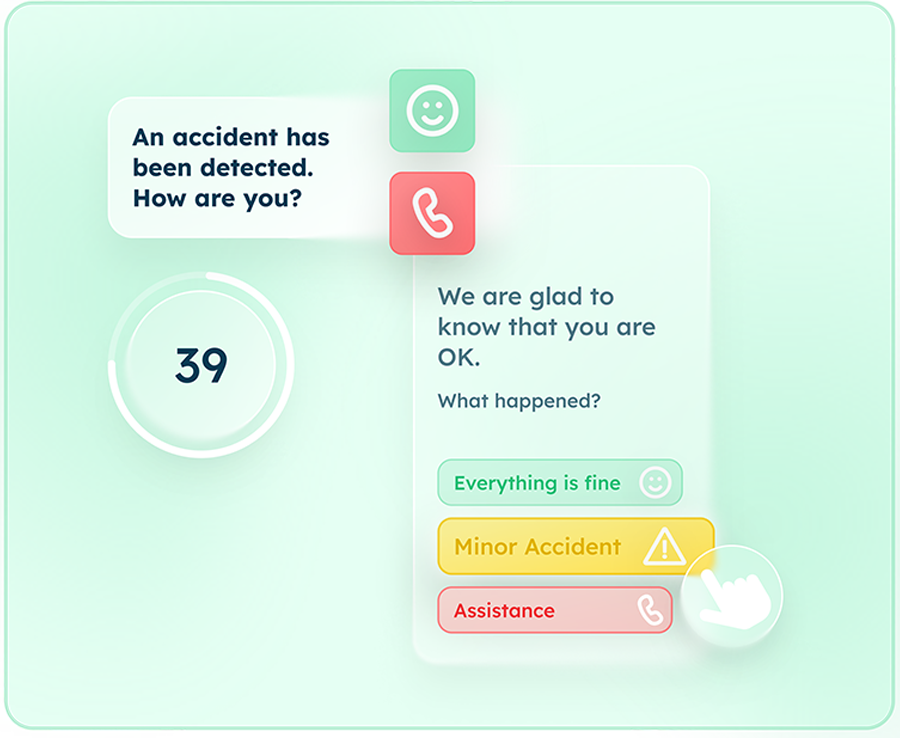Is crash detection supported by all smartphones?
Our service can be installed on all Android phones that support at least Android 8 and all iPhones that support iOS 12.
Does crash detection work everywhere?
There are no geographical limitations. The only requirement is that the area must be covered by a GPS signal. In fact, measuring GPS speed is essential to capture a vehicle's displacement and to analyze its behavior during and after an accident.
Does the smartphone need to be connected to a mobile network?
Mobile network and mobile data are essential to guarantee the immediate analysis of the data on our platform as well as the transmission of the information to an assistance platform who can dispatch emergency services. If the phone is not connected to mobile data, the accident data will be retained and transmitted automatically as soon as the phone is reconnected.
When is crash detection active?
Crash detection is active continuously while a trip is being recorded. Trip recording is automatically triggered by the DriveKit SDK, which can detect a vehicle's displacement even when the application is running in the background.
Does it drain the phone battery?
Energy consumption is marginal. The application doesn’t drain the phone's battery except when the policyholder is driving. In that case, power consumption is mainly due to the use of the GPS sensor. The on-device accident detection strategy doesn’t increase the battery consumption.
What are the data collected?
To detect and confirm an accident, the data recorded and transmitted to the analysis platform are as follows: 40 seconds of GPS data (sampled at 1 Hz) and 15 seconds of acceleration data (sampled at 100 Hz) centered on the instant of collision.
How are data transmitted?
The data is transmitted via an API to your assistance or claims management platform.
How long does it take to confirm an accident?
Collision detection on the phone is instantaneous. It then takes 20 seconds to record the post-collision data before sending it to the analysis platform. Processing on the platform takes less than a second. As soon as the crash is confirmed, the info is sent to the insurer's platform. Overall, it takes less than 30 seconds from the time of collision to get crash data on your platform.
Is it possible to adapt the crash detection according to the use case?
We have integrated a supervisor that can reject collisions based on speed and force at the moment of impact. These values can be finetuned according to your needs.
Is crash detection reliable at very low speeds?
The lower the speed, the less energy is transmitted to the phone's accelerometer. Accident detection is therefore less effective at low speeds (under 10 km/h). This limitation is not critical for assistance purposes, since the collision is not very severe and generally does not involve physical injury.
Can an alert be generated if the driver drops his phone?
No, data processing algorithms can differentiate between a dropped phone and a shock caused by an accident.
How can I avoid sending emergency calls in the event of a false positive?
If an accident is confirmed on our platform, the information is sent back to the SDK installed in the policyholder's mobile application. This signal triggers the smartphone to share the vehicle's location. This is a way to find out whether the driver is continuing his trip after the accident. If so, there's no need to call the emergency services.
Is it possible to check that the driver is all right?
Yes, when an accident is confirmed on our platform, the information is returned to the SDK installed in the policyholder's mobile application. This signal can trigger a notification to ask the driver if he needs assistance. If he doesn't respond after 60 seconds, it's probably time to call for help.












![[2025 Edition] The Guide to Connected Insurance](https://www.drivequant.com/hubfs/7-%20%5BEdition%202025%5D%20Le%20Guide%20de%20lAssurance%20Connect%C3%A9e.png)
